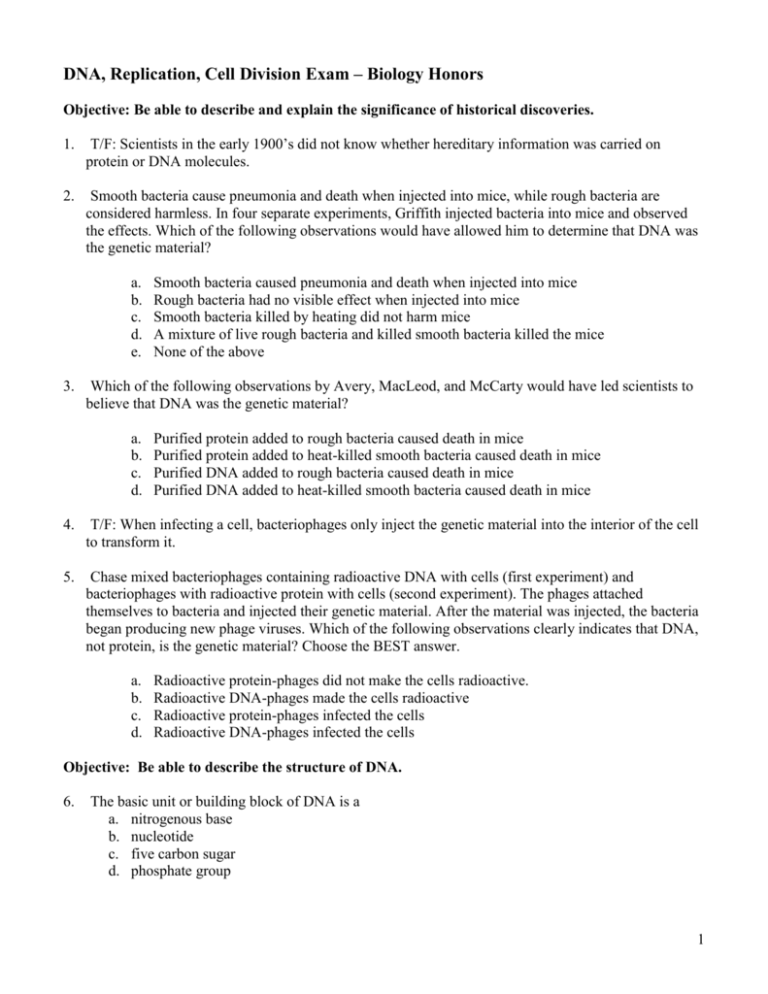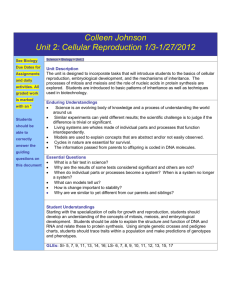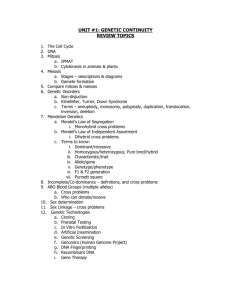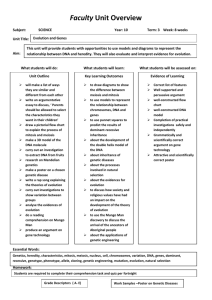Unit 5 Exam - DNA, Rep, Mitosis honors key
advertisement

DNA, Replication, Cell Division Exam – Biology Honors Objective: Be able to describe and explain the significance of historical discoveries. 1. T/F: Scientists in the early 1900’s did not know whether hereditary information was carried on protein or DNA molecules. 2. Smooth bacteria cause pneumonia and death when injected into mice, while rough bacteria are considered harmless. In four separate experiments, Griffith injected bacteria into mice and observed the effects. Which of the following observations would have allowed him to determine that DNA was the genetic material? a. b. c. d. e. 3. Smooth bacteria caused pneumonia and death when injected into mice Rough bacteria had no visible effect when injected into mice Smooth bacteria killed by heating did not harm mice A mixture of live rough bacteria and killed smooth bacteria killed the mice None of the above Which of the following observations by Avery, MacLeod, and McCarty would have led scientists to believe that DNA was the genetic material? a. b. c. d. Purified protein added to rough bacteria caused death in mice Purified protein added to heat-killed smooth bacteria caused death in mice Purified DNA added to rough bacteria caused death in mice Purified DNA added to heat-killed smooth bacteria caused death in mice 4. T/F: When infecting a cell, bacteriophages only inject the genetic material into the interior of the cell to transform it. 5. Chase mixed bacteriophages containing radioactive DNA with cells (first experiment) and bacteriophages with radioactive protein with cells (second experiment). The phages attached themselves to bacteria and injected their genetic material. After the material was injected, the bacteria began producing new phage viruses. Which of the following observations clearly indicates that DNA, not protein, is the genetic material? Choose the BEST answer. a. b. c. d. Radioactive protein-phages did not make the cells radioactive. Radioactive DNA-phages made the cells radioactive Radioactive protein-phages infected the cells Radioactive DNA-phages infected the cells Objective: Be able to describe the structure of DNA. 6. The basic unit or building block of DNA is a a. nitrogenous base b. nucleotide c. five carbon sugar d. phosphate group 1 Above is a rough sketch of a nucleotide. Match the words below to the letters in the picture above. 7. 8. 9. Nitrogenous base Phosphate group 5 Carbon Sugar 10. DNA makes up a. Spindle fibers b. Centrioles c. Chromosomes d. Centromeres , which are found in the nucleus. 11. In a DNA molecule, Cytosine pairs with a. Guanine b. Thymine c. Cytosine d. Glycerol 12. The strong backbone of the DNA molecule is made from bonds between a. The nitrogenous bases and the phosphate b. The phosphate and the sugar c. The sugar and the nitrogenous bases d. The nitrogenous bases with the nitrogenous bases Objective: Be able to describe the process and importance of DNA replication. 13. TAC-CAG-GGC: Which of the following strands was synthesized from this strand? a. ATG-GTC-CCG b. TAC-CTG-ATA c. UAC-CUG-AUA d. AUG-GUC-CCG 14. 15. 16. 17. 18. Helicase Single stranded binding proteins Primase DNA polymerase DNA Ligase a. Forms sugar-phosphate bond between Okazaki fragments b. Lays down RNA primer to initiate DNA replication c. Breaks hydrogen bonds between nucleotides d. Adds complementary nucleotides in 5’ 3’ direction e. Holds DNA strands apart 2 Objective: Be able to state the importance of, and identify and explain the different phases of the cell cycle. 19. Why is it important that an organism’s cells divide? a. growth b. repair c. reproduction d. all of the above 20. When does a cell grow, replicate genetic material, and produce new organelles? a. Interphase b. Anaphase c. Telophase d. Prophase 21. In which phase is DNA replicated? a. Prophase b. Interphase c. Metaphase d. Anaphase Match the description on the left with the correct stage on the right. 22. Spindle fibers arrange chromosomes in the middle of the cell. a. b. c. 23. Spindle fibers pull sister chromosomes to opposite sides of the cell. 24. Genetic material condenses to form chromosomes. d. e. 25. Chromosomes uncoil and two new nuclear envelopes form. 26. What is the importance of the above stages? a. genetic information is distributed so that the new daughter cells have the same information as the parent cell. b. Genetic information is distributed so that the new daughter cells have half the information as the parent cell. c. Genetic information is doubled so that the new daughter cells have double the information as the parent cell. d. Genetic information is not distributed at all. 3 27. What is the function of the centriole and spindle apparatus? a. To arrange the locations of chromosome position. b. To dissolved the nuclear membrane. c. To cause cytokinesis. d. To synthesis new DNA. Objective: Summarize the stages of meiosis and understand the significance of the process. 28. A hamster has 22 chromosomes in a monoploid (haploid) cell. How many chromosomes does a diploid hamster cell have? a. 11 b. 22 c. 44 d. 88 29. The purpose of meiosis is to make cells that have somatic (body) cells do. a. The same b. Double c. Half d. Four times the number of chromosomes that 30. Homologous pairs contain a. Two chromosomes b. One chromosome from each parent c. Both a and b d. None of the above 31. During meiosis, chromosomes are distributed to each daughter cell: a. Randomly b. In a pattern c. Next to certain chromosomes d. Individually Objective: Understand the significance of the similarities and differences b/w meiosis and mitosis. 32. Which cell division type is capable of producing monoploid (haploid) cells? a. Mitosis c. Meiosis b. Both d. Neither 33. Genetic variation is often possible as a result of meiosis, but rarely mitosis. Which of the following choices best explains why this is true? a. Chromosomes in mitosis often overlap and exchange DNA b. Chromosomes in meiosis often overlap and exchange DNA c. Chromosomes assort themselves independently in metaphase of meiosis d. Both B and C e. A, B, and C are true 4 34. T/F: Mitosis produces daughter cells that are identical to the original, while daughter cells of meiosis are often non-identical. 35. Meiosis produces four daughter cells, while mitosis produces two. Which statement best explains why? a. A fourth round of divisions in meiosis is responsible for the four daughter cells. b. Mitosis has two divisions, while meiosis only has one. c. Cells produced by mitosis are monoploid, the result of the unique arrangement during metaphase. d. Meiosis has two divisions, while mitosis only has one. Objective: To relate basic scientific knowledge to applied research. 36. Some cancer cells produce an enzyme called telomerase. This enzyme causes telomeres to… a. shorten and therefore extends the life of the cell. b. lengthen and therefore extends the life of the cell. c. shorten and therefore shortens the life of the cell d. lengthen and therefore shortens the life of the cell. 37. A drug that could be helpful to cancer patients would target only the cancerous cells and… a. Add telomerase. b. Add telomeres to the ends of the chromosomes. c. Remove telomerase. d. Remove telomeres. e. Either c or d. 5








